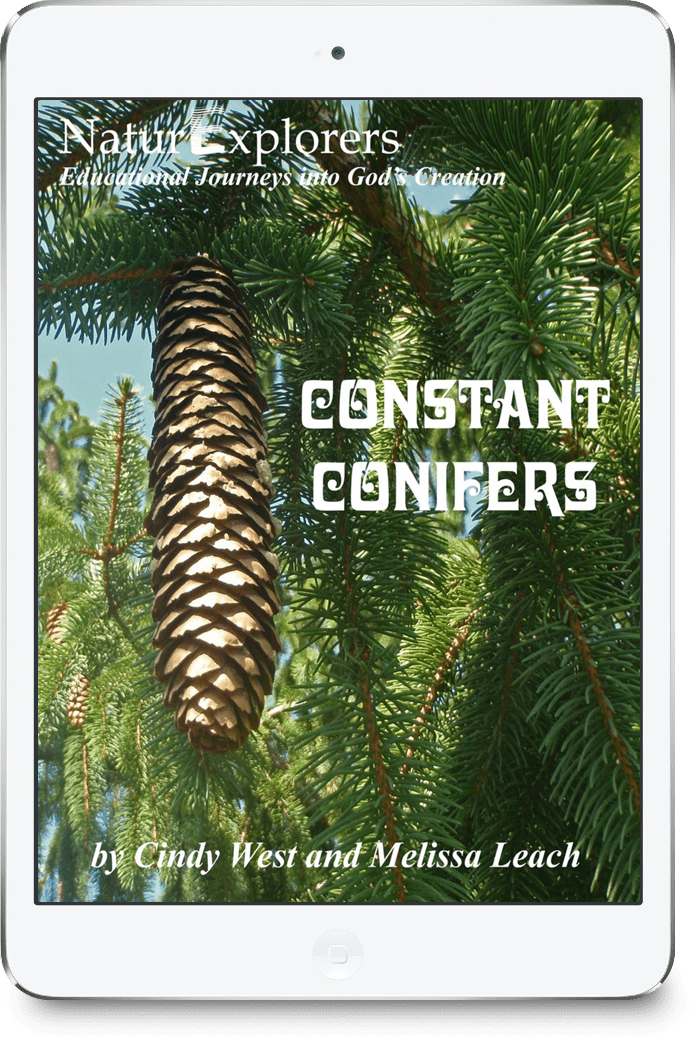Creation Club – Evergreens, Focusing on Conifers
Our Creation Club started again! And, as usual, the Lord blessed us with absolutely beautiful weather! This month’s topic turned out to be more timely than I ever imagined when planning it. I had anticipated just getting to talk about certain aspects of conifers because I assumed we couldn’t possibly find examples of every stage of cone development. Boy was I wrong! The kids were able to find examples of each and every thing we talked about today.

We met in a local cemetery that was established in 1860. It houses many, many examples of wonderful evergreens, and specifically conifers. After a discussion of the differences between evergreens and deciduous trees, we talked about differences between needle-like and broad leaf evergreens – and were able to find plentiful examples of each.
Once understanding the distinctions of a conifer (cone-producing) evergreen, I asked the children to find a conifer and bring at least a cluster of its leaves back to our study spot. I had them observe the leaves closely under magnifying glasses, look for a waxy covering and break apart the leaves to find the liquid.

Next, we moved on to the cones. I asked them to try to locate one cone that was open and one that was closed. We talked about how the cones are the “fruit” of the conifer, how the scales house the tree’s seeds and open up to drop seeds when they are mature. I introduced the term “gymnosperm” as a “naked seed” – or a seed not housed in a fleshy fruit. We talked a little about how the cones will grow flowers – male and female on the same tree – in order to pollinate. I never expected the kids to be able to find flowers this time of year, but you’ll see below that they did! We were also able to open up some of the scales to find seeds already! Some of the children dissected their pine cones to reveal the inner “vein” that delivers food from the tree. Do you know how sticky and sappy evergreen food is??




Finally, each child was given a notebooking page (which you can see here). They had to find a conifer, identify it using tree field guides and complete the info on the notebooking page. In walking around to help them, I was amazed at the vast diversity between tree types in this small cemetery alone! Big cones, tiny cones, shaggy bark, smooth bark, needle leaves, rough leaves. Amazing!

Some woodpecker had a feast of sugary sap from this fir tree.

Anyone have an explanation for these rings? It’s a pine tree of some sort, we couldn’t quite pin down the exact type. The rings were beautiful, but we were puzzled as to the cause. A parasite??

I sent them home to try a cone experiment. Did you know cones will close and open depending on the humidity? They each took home at least one open cone. They are supposed to put it in water for an hour to watch it close. Afterwards, they are supposed to let it dry overnight to watch it open again. This is one of God’s mechanisms to protect the seeds from rain before they’re ready to fall from the cone. Nature never ceases to teach me something new about God!
Dont’ be intimidated to study conifers – they are so amazing! Constant Conifers provides you with loads of info and activities to keep engaged and excited!


Great nature study! I noticed this week that the evergreens are sending out new growth and it is so pretty.
Our deciduous trees are all starting to blossom and leaf out so the evergreens aren’t so noticeable.
I enjoyed reading your entry.
Barb-Harmony Art Mom
We’re Evergreen Nature Study Club in Guyana, south america. We would love to be part of the greater evergreen family in this world.
Cheers!